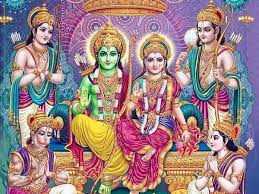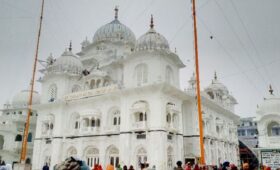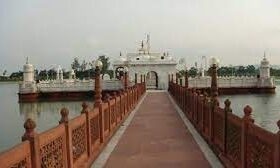Ramayana is not just another tale it is an influential allegory –an influential allegory – an indispensable part of Hindu rellgious cannon The land of Bihar is palce which replete with stories from the epic Ramayana written by sage Valmiki Muni There are many places which are connected to different occasions of Goddess Sita and Lord Rama’s life According to believes Mithila state was once facing adverse drought conditions. To Impress Lord indra for rain king janak started plowing a field, A time had come when the plowing reached panaura and the plough hit a vessel broke and Broke and Goddness sita sprung to life Thereafter this place is known as Sitamarthi the King Janaka of Videha and his wife Sunaina adopted Sita. Thereafter the place is known as Sita kund Bihar Goddness to demon killing by God Ram and rescuing a lady like devi Ahalya from a curse.
JANAKI TEMPLE ( PUNAURA):
This temple is about 5km south west of Sitamarhi This temple is claimed to be the birth place of Sita and is considered to be sacred place where people go for a pilgrimage.
JANAKI TEMPLE (SITAMARHI):
This more than 100 year old Hindu temple, situated near Sitamarhi, is related to Goddess Sita’s life The Temple, is believed to be the birth place of Goddess Sita.
PANTH PAKAR (SITAMARHI):
An age old banyan tree Still stands here about 8km north east of Sitamarhi It is said that when Sita left Janakpur in a palanquin for Ayodha after the marriage with Shri Ram she was given rest for a while under this very banyan tree.
HALESHWAR STHAN (SITAMARHI):
This is an ancient temple of Lord Shiva about 3km north west of sitamarhi according to myths the King of Videha on the occasion of Putrayesthi Yagna, founded this temple.
AHILYA STHAN (DARBHANGA):
The village is situated about 24km north west of Darbhanga and about 4 km from kamtaul Railway Staion It is known for the temple of Ahilya which is associated with the well known legend of the sage Gaoutam and his wife Ahilya as told in the epics and Puranas Inside the Shrine is a flat stone said to contain the foot prints of Sita wife of Ram as the main object of worship.
CHANKI GARH WEST (CHAMPARAN):
Also known as Janaki Garh this village is situated about 9km east of Ram Nagar Railway Station. There is a large mound in the eastern part of the village. It is a mass of solid brickwork and is 90 feet high it was probably originally a fort and the remains of fortification can still be seen. The local tradition asserts that is was a fort of King Janak.
VALMIKI NAGAR (WEST CHAMAPARAN):
This is a village on the indo Nepal border 42 km north east of Bagaha to which it is connected by a metal road. There is a Valmiki Ashram. Which is said to be the place where Maharshi Valmiki lived. On the occastion of Makar Sankranti Every year a fair is held on the bank of River Gandak. Besides on old Shiva temple of Nara Devi and Gauri Shankar at Valmiki nagar.
SINGHESHWAR STHAN (MADHEPURA):
Singheshwar Sthan has been the abode of Lord Shiva form the ancient times Thogh there are various stories about establishment of the Singheshwar temple the one that is widely and popularly of the Singheshwar temple the one that is widely and popularly accepted related to Rishi Shringi In the ancient time Singheshwar was situated on the bank of the river Kosi and was surrounded by dense and lush green forest It was ideally situated for Tapasya (Meditation) and it is here that Vibhandak Rishi along with his son Rishi Shringi devoted all his time in deep meditation
(PHULLAHA MADHUBANI):
Situated about 6 km west if the block headquarters at Umgaon the village houses temple of Goddess Girija It is said that Sita the daughter of King Janak used to come here everyday to worship the Goddness. Lord Rama saw her for the time at this place.
PRETSHILA HILLS (GAYA):
About 8 km north – west of Gaya, the 873 feet high pretshila Hills is situated. The literal meaning is Hill of Ghosts On the top of the hill is a small temple apporiately meaning to yam (The God of death).
(KAKO JEHANABAD): Situated 10 km east of Jehanabad Railway station It is believed that Lord Ramchandra stepmother, Rani Kaikeyi of Ayodhya lived here for some time and the village took its name after her. The village also has a tomb of Hazarat Bibi Kamal Sahiba, a great muslim lady saint it is said that this lady was th aunt of Haryat makdum Saheb of Bihar Sharif possessed divine powers.
RAINCHURA (VIAISHALI):
This place is situated in Vaishali block where a fair is held every year on Ram Nawami day The Local tradition has it that lord Ram Chandra had a stopover here for a bath on his way to Janakpur. There are some marks on stone, which are said to be his footprints.
AHIRAULI (BUXUR):
Situated about 5 km north Ram Chandra and his younger brother Lakshman with their teacher Rishi Vishwamitra had crossed the Ganga here on their way to janakpur where Lord Ram took part in the Sita swayamwar (the public ceremony of Sita’s marriage).
TAR (BHOJPUR):
Situated about 10 km norh west of Piro, the village derives its name form Tarka a she demon killed by lord Rama there is an old tank in the village that is said to be the wrestling ground of Tarka.
GIDDHESHWAR (JAMUI):
According to local legends on Ravan’s Way back to Lanka after abducting Sita the epic fight between the vulture Jatayu and Ravan took place here on the hill that is situated about 13 km south of Jamui There is a temple of Lord Shiva, which draws big crowds on the occasion of Shivratri and Maghi Purnirna.
SITA KUND (MUNGER):
Situated in a village about 6 km east of the Munger town there is a hot spring known as the Sita Kund The story goes that Lord Rama, after resuuing his wife Sita from the demon king Ravan, suspected her chastity her chastity and sita, to prove her chastity agreed to enter blazing fire, she came but the pool in which she bathed. The hot spring is now enclosed in a masonry reservoir and is visited by large number of pilgrims especially at the full moon of Magh.



